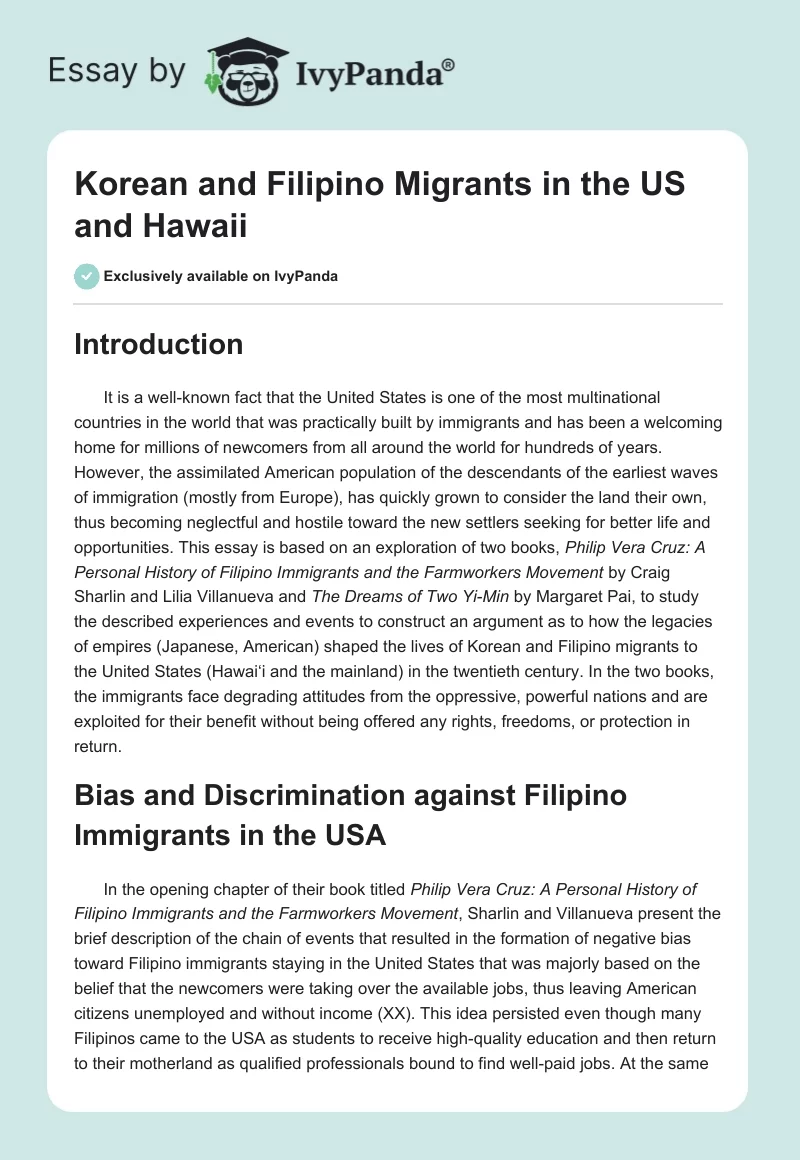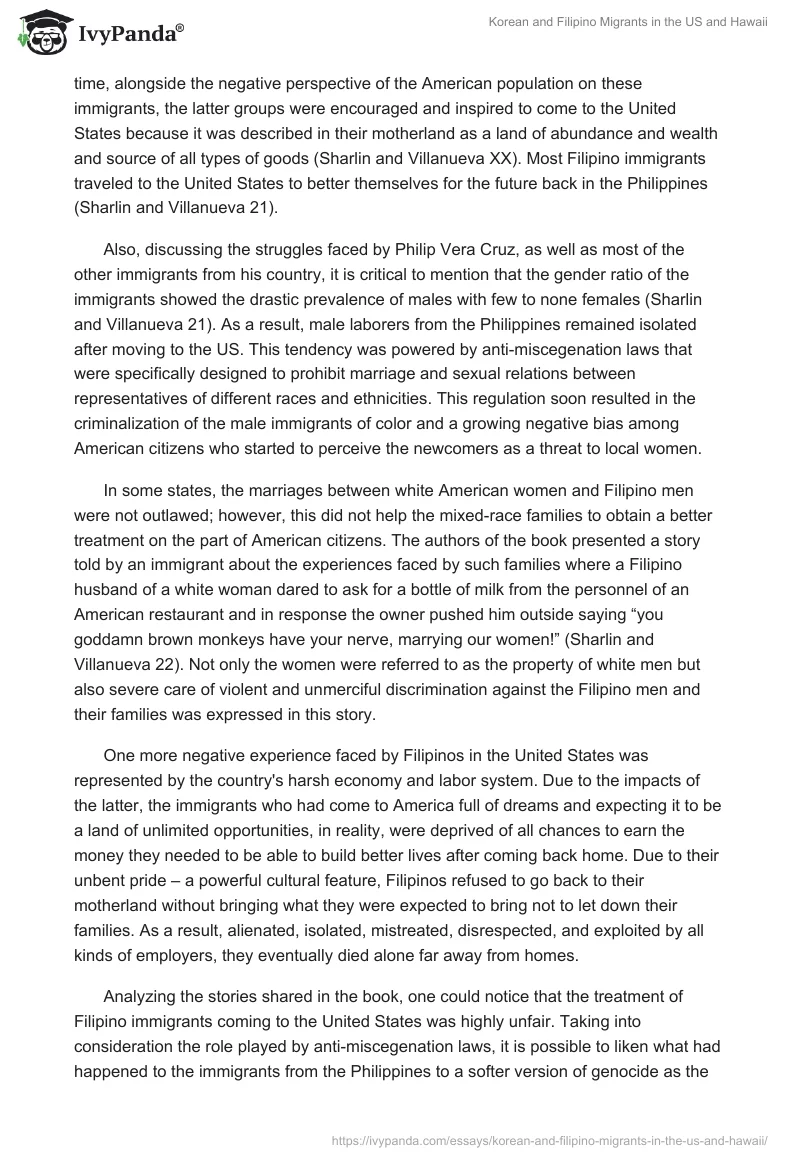Introduction
It is a well-known fact that the United States is one of the most multinational countries in the world that was practically built by immigrants and has been a welcoming home for millions of newcomers from all around the world for hundreds of years. However, the assimilated American population of the descendants of the earliest waves of immigration (mostly from Europe), has quickly grown to consider the land their own, thus becoming neglectful and hostile toward the new settlers seeking for better life and opportunities. This essay is based on an exploration of two books, Philip Vera Cruz: A Personal History of Filipino Immigrants and the Farmworkers Movement by Craig Sharlin and Lilia Villanueva and The Dreams of Two Yi-Min by Margaret Pai, to study the described experiences and events to construct an argument as to how the legacies of empires (Japanese, American) shaped the lives of Korean and Filipino migrants to the United States (Hawai‘i and the mainland) in the twentieth century. In the two books, the immigrants face degrading attitudes from the oppressive, powerful nations and are exploited for their benefit without being offered any rights, freedoms, or protection in return.
Bias and Discrimination against Filipino Immigrants in the USA
In the opening chapter of their book titled Philip Vera Cruz: A Personal History of Filipino Immigrants and the Farmworkers Movement, Sharlin and Villanueva present the brief description of the chain of events that resulted in the formation of negative bias toward Filipino immigrants staying in the United States that was majorly based on the belief that the newcomers were taking over the available jobs, thus leaving American citizens unemployed and without income (XX). This idea persisted even though many Filipinos came to the USA as students to receive high-quality education and then return to their motherland as qualified professionals bound to find well-paid jobs. At the same time, alongside the negative perspective of the American population on these immigrants, the latter groups were encouraged and inspired to come to the United States because it was described in their motherland as a land of abundance and wealth and source of all types of goods (Sharlin and Villanueva XX). Most Filipino immigrants traveled to the United States to better themselves for the future back in the Philippines (Sharlin and Villanueva 21).
Also, discussing the struggles faced by Philip Vera Cruz, as well as most of the other immigrants from his country, it is critical to mention that the gender ratio of the immigrants showed the drastic prevalence of males with few to none females (Sharlin and Villanueva 21). As a result, male laborers from the Philippines remained isolated after moving to the US. This tendency was powered by anti-miscegenation laws that were specifically designed to prohibit marriage and sexual relations between representatives of different races and ethnicities. This regulation soon resulted in the criminalization of the male immigrants of color and a growing negative bias among American citizens who started to perceive the newcomers as a threat to local women.
In some states, the marriages between white American women and Filipino men were not outlawed; however, this did not help the mixed-race families to obtain a better treatment on the part of American citizens. The authors of the book presented a story told by an immigrant about the experiences faced by such families where a Filipino husband of a white woman dared to ask for a bottle of milk from the personnel of an American restaurant and in response the owner pushed him outside saying “you goddamn brown monkeys have your nerve, marrying our women!” (Sharlin and Villanueva 22). Not only the women were referred to as the property of white men but also severe care of violent and unmerciful discrimination against the Filipino men and their families was expressed in this story.
One more negative experience faced by Filipinos in the United States was represented by the country’s harsh economy and labor system. Due to the impacts of the latter, the immigrants who had come to America full of dreams and expecting it to be a land of unlimited opportunities, in reality, were deprived of all chances to earn the money they needed to be able to build better lives after coming back home. Due to their unbent pride – a powerful cultural feature, Filipinos refused to go back to their motherland without bringing what they were expected to bring not to let down their families. As a result, alienated, isolated, mistreated, disrespected, and exploited by all kinds of employers, they eventually died alone far away from homes.
Analyzing the stories shared in the book, one could notice that the treatment of Filipino immigrants coming to the United States was highly unfair. Taking into consideration the role played by anti-miscegenation laws, it is possible to liken what had happened to the immigrants from the Philippines to a softer version of genocide as the vast majority of men coming to the USA for work remained unmarried and childless for the rest of their life, thus significantly diminishing the size of the population of the Philippines. The extreme conditions in which the laborers were put immediately placed them at the very bottom of the American society, this way, exposing them to a variety of threats such as hate crimes and discrimination, workplace exploitation, poverty, social isolation, and deprivation of healthcare services of the needed quality, to name a few.
In the story of Philip Vera Cruz, the legacy of the American Empire is seen in the treatment received by the Filipino laborers. The citizens of the United States seemed to have demonstrated a very dualistic perspective on people subdividing them into “citizens” or “Americans” and “others”. In their view, “others” were to be feared and alienated as the unwanted intruders bringing unknown changes. This belief could be practiced in both intentional and unintentional manner and both cases are harmful and discriminatory towards the minority group.
Moreover, the division was not only based on citizenship. Race and ethnicity played a very significant role in serving as some of the major determiners of prejudice and negative attitude. One could notice clear signs of white supremacy typical for the American empire. The latter phenomenon merged with the negative bias of the assimilated locals toward the newcomers and, as a result, the Filipino workers ended up becoming victims of the American society, economy, and labor system instead of benefiting from them.
The Challenges Faced by Korean Immigrant Laborers in Hawaii
Similarly to every story of an immigrant to the United States regardless of the decade when he or she relocated for the first time, the story in The Dreams of Two Yi-Min begins by mentioning the hard labor of the newcomers and the harsh and exhausting conditions they had to face. Similarly to the situation in the relation between the American and Filipino laborers in Philip Vera Cruz: A Personal History of Filipino Immigrants and the Farmworkers Movement, the workers from Korea coming to Hawaii faced restrictions due to the likelihood that the number of Koreans could exceed that of the Japanese workers in the market (Pai 3). This tendency was enforced by the international affairs of Korea and Japan where the latter state took over the former bringing many soldiers and establishing limiting rules. The Koreans who managed to immigrate to the United States before the invasion were lucky to have escaped it. In contrast with the previous book elaborating on the experiences of the Filipino men coming to work in the USA, the book by Pai presents a story of the Korean women who came to the new shores as brides in the marriages arranged by go-betweens and were only able to meet the men waiting for them after the arrival.
The oppression suffered by Koreans from their neighbors was harsh and lasted for a long time. The proud and unified national spirit of Koreans showed itself in their national desire to demonstrate their striving for liberty and the unfair oppression. The demonstration was expected to attract the attention of the global community so that the other, more powerful states could intervene and help Koreans win their freedom (Pai 22).
The treatment the participants of the demonstration received was utterly horrific. Their oppressors did not hold back and threw their forces on the Korean people, thus subduing the demonstration within minutes, injuring and killing many of its participants, and detaining the others.
Overall, the experiences of the Korean people who had moved to Hawaii described by Pai made it clear that these people were caught between two systems harsh toward them – their old home was taken over by the Japanese establishing their diminishing rules and treating Koreans without any respect and their new home in Hawaii was dominated by the citizens, thus putting the immigrants in a highly limiting position and depriving them of chances to have a better life, save money, or access healthcare services. In that way, it is possible to notice that the Korean immigrants depicted by Pai were mistreated by two empires at the same time. The legacy of the American Empire brought alienation and depowered the newcomers keeping them so poor that they were not even able to go back home. Also, returning to Korea, the immigrants would face an even more threatening empire – the Japanese whose legacy was to promote the supremacy of the Japanese people and culture to the populations of the oppressed. The dominant and extremely violent attitude of the Japanese leaders and militia toward the people of Korea could be likened to the history of any other colonization that turned the colonized people into slaves without rights.
Conclusion
The stories told in the two books reviewed in this paper have many similarities that mainly represent the struggles and problems experienced by the immigrants from different countries in the United States – they were depowered, limited, neglected, had to live in poverty, and, often, face isolation from the rest of the American society. Also, the immigrants of the two nations – Filipino and Korean – faced the oppression forced by stronger states dictating their rules and exploiting the laborers without offering them any rights, freedoms, or protection.


